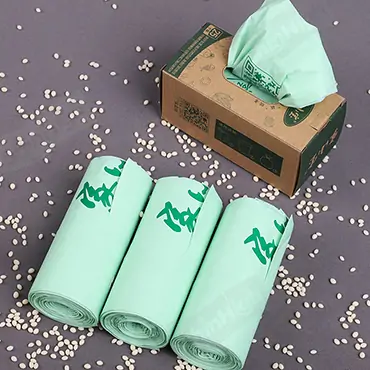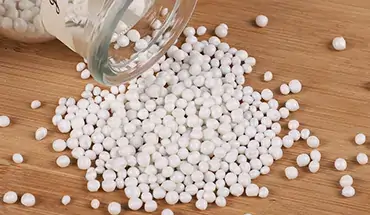Severe Plastic Pollution
Every year, factories around the world produce over 400 million tons of plastic. About 50% of this plastic is used only once, such as plastic bags, straws, and spoons, which are thrown away right after use. So far, 7 billion tons of plastic waste have been created worldwide, but less than 10% of it is recycled. The rest ends up in landfills, where it takes up space and even produces hazardous components. As plastic flows from land to sea, countless marine organisms suffer entanglement and internal injuries from contact with or ingesting plastic products. Over one million marine animals have died due to plastic pollution in the ocean!

What Makes Plastic a Problem?
Conventional plastics are mainly made of polyethylene (PE), polypropylene (PP), polystyrene (PS), polyvinyl chloride (PVC), and others.
Due to their high molecular structure and bond strength, large plastic waste takes a long time to decompose under physical, biological, and chemical effects.
These plastics break down into small pieces, known as microplastics, which are invisible to the naked eye. But they’ll never disappear. Microplastics are easily ingested by living things but cannot be digested, leading to illness and even death as they accumulate in the stomach.
Can We Solve Plastic Pollution?
Scientists have identified a new bacterium, Ideonella sakaiensis, that produces enzymes to break down plastic.
Even though scientists have identified the genes that regulate the enzyme in this bacterium and are replicating the enzyme in large quantities in the lab, it still cannot keep up with the rate at which humans are producing plastic.
To reduce plastic pollution, we need to recycle more and use materials that break down more easily, called degradable materials. Degradable materials can be divided into bio-based and petrochemical-based types. PLA and PBAT are currently cost-effective options in the biodegradable plastics industry.
PLA is a biodegradable material made from high-starch crops like corn and cassava. These crops are fermented by microorganisms to produce lactic acid, which is then polymerized.
PBAT is made from terephthalic acid, adipic acid, and butanediol, all derived from non-renewable petroleum. Even though PBAT is based on petroleum, it still has degradable properties.
Products made from both PLA and PBAT can be broken down into water, carbon dioxide, energy, and new biomass under composting conditions.
What Can Biodegradable Plastics Be Used For?
Are you wondering what biodegradable plastics can be used for and if they can truly replace conventional plastics in our daily lives? The answer is increasingly yes! Biodegradable plastics offer a promising alternative, particularly in addressing environmental concerns related to plastic waste. Let’s explore their diverse applications and potential impact.
Biodegradable Plastics in Agriculture: A Sustainable Solution
One critical application of biodegradable plastics lies in agriculture, specifically as a replacement for conventional plastic ground cover film. Conventional polyethylene (PE) films, often used as mulch, help increase soil temperature, retain moisture, and control pests. However, these non-degradable films contribute significantly to soil pollution. For instance, areas like Xinjiang, China, can experience extreme film residue buildup, negatively impacting plant growth and making recycling difficult.
Benefits of Biodegradable Mulch: Biodegradable agricultural film presents a solution to these challenges. It decomposes naturally, eliminating the issue of plastic residue and boosting crop yields. This sustainable approach benefits regions prone to drought, water scarcity, and low temperatures by promoting agricultural productivity without harming the environment.
Beyond Mulch: Biodegradable materials are also making inroads in agricultural pesticides and slow-release fertilizer applications, further reducing the reliance on harmful chemicals and non-degradable packaging.
Biodegradable Plastics in Packaging and Food Service: Reducing Waste
The packaging industry presents another significant opportunity for biodegradable plastics. Common plastic takeaway containers and food packaging, often contaminated with grease and food residue, are difficult to recycle and can take hundreds of years to decompose. This contributes to landfill waste and environmental pollution.
Compostable Food Containers: Biodegradable plastic lunch boxes, however, can decompose in as little as three months, significantly reducing their environmental footprint.
Versatile Packaging Applications: Beyond lunchboxes, biodegradable plastics are suitable for shopping bags, garbage bags, compost bags, instant noodle bowls, and protective cushioning materials, offering a complete replacement for common plastic packaging.
Beyond Packaging: Diverse Applications of Biodegradable Plastics
The versatility of biodegradable plastics extends beyond agriculture and packaging:
- Hygiene Products: Biodegradable plastics are used in diapers, providing anti-bacterial properties beneficial for infants.
- Medical Field: Biodegradable plastics are found in bandages, gloves, drug release materials, surgical sutures, cardiac stents, and fracture fixation materials.
- Sporting Goods: Even items like golf course spikes are now being made from biodegradable plastics.
Important Considerations: Addressing Greenwashing and Ensuring Proper Decomposition
While the potential of biodegradable plastics is substantial, it’s crucial to be aware of “greenwashing.” Some manufacturers make unsubstantiated claims about their products’ compostability. True compostable plastics should break down into carbon dioxide, water, mineralized inorganic salts, and biomass under composting conditions.
The Importance of Proper Certification: The end product should meet stringent standards for heavy metal content, toxicity, and residual debris. It’s vital for consumers and businesses alike to choose products that are genuinely certified as biodegradable and compostable.
How to Find Trustworthy Manufacturers?
To avoid dishonest producers, it’s important to check the producer’s qualifications and whether they have been tested by certification bodies like BPI, ABA, and Din Certco.
If you’re looking for a trustworthy supplier, Dongguan Xinhai Environmental Protection Material Co., Ltd. is a good choice. The company has focused on researching, developing, and producing compostable plastic raw materials, various bags, and related equipment for over 20 years. It can meet your various needs.

What We Can Do About Plastic Pollution?
Lastly, degradable plastics are part of the solution, but they’re not perfect. We should still reduce our use of disposable plastics, recycle more, and choose eco-friendly materials. Let’s reduce our use of disposable plastic products, choose biodegradable and eco-friendly materials, and work together to protect our home. By working together, we can make the Earth a cleaner, healthier place for future generations.







